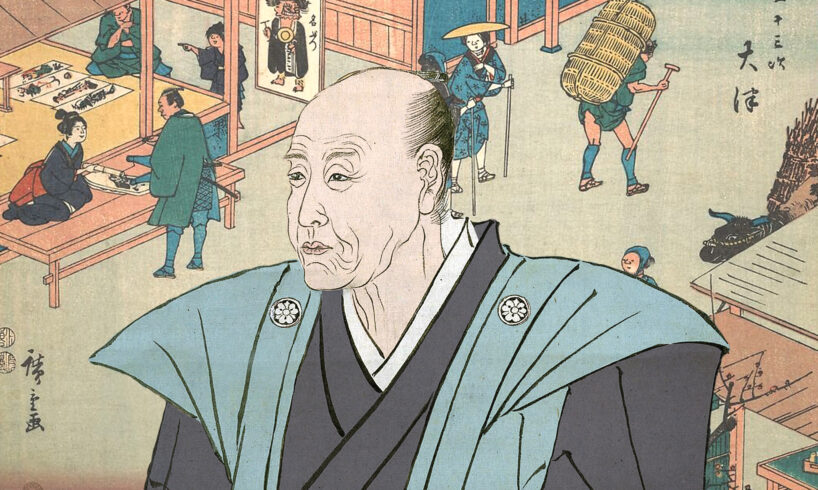
During the Edo period (1603 – 1867), the job of old-Tokyo’s machi-bugyo city magistrate was really three jobs hiding inside one big overcoat. The post was the modern equivalent of the chief of police overseeing samurai cops, co-mayor of the largest city on the planet (since there were two machi-bugyo at any given time) and high-court judge. It wasn’t exactly a job with many friends — except in one case. One machi-bugyo was so beloved by the people of Edo, they immortalized him in theater plays, books and rakugo comedy routines. This is the story of Ooka Tadasuke, the Japanese Solomon.
The Impressive Resume of Ooka Tadasuke
Ooka Tadasuke (1677 – 1752) was the son of a direct retainer of the shogun, but he didn’t land the post of an Edo magistrate from a well-placed crib. He first obtained a minor administrative job and climbed the feudal bureaucracy ladder, eventually becoming the Yamada magistrate, overseeing Ise Province and the Ise Grand Shrine, one of the most important places of Shinto worship in Japan and oddly enough, a symbol of peasant rebellion. For most, that would have been enough, but Ooka Tadasuke wasn’t most people.
Tadasuke later became Edo’s southern machi-bugyo, governor of Echizen Province — which is why he’s sometimes known as Ooka Echizen — then magistrate of temples and shrines, and finally the daimyo (great feudal lord) of a domain in what is today Aichi Prefecture. He remains the only Edo bureaucrat to achieve the position of fief-holding lord. But that’s not what people remember about him. Tadasuke’s legacy is forever tied to his time as Edo’s de facto CEO. Here’s why:
Depiction of Edo Firefighter in uniform, from “Moon in the Flame” by Yoshitoshi (1996) | Wikimedia
The Man Who Loved Edo
Tadasuke’s time as police chief, judge and mayor of Edo wasn’t a mere stepping stone in his career. He saw the job as a chance to improve his city. He cracked down on suicide pacts, organized Edo’s first commoner fire brigades and established the Koishikawa Yojosho, a free public hospital that was later immortalized in Akira Kurosawa’s Red Beard. He also encouraged the cultivation of sweet potatoes to prevent famine and essentially invented copyright law by suggesting publishers to include ownership imprints inside of books.
Then there were his judicial decisions. Ooka Tadasuke distinguished himself by refusing to use torture to extract confessions (a low bar for praise today but, at the time, nearly saintly) and for mixing written law with humor, humanity and mercy.
Depiction of Ooka Tadasuke, artist unknown | National Diet collections, Wikimedia
Ooka the Wise
Tadasuke’s time as a judge has been so mythologized in feudal popular culture to the point that it’s impossible to know which stories are true. Still, assuming each tale has a grain of truth, his most famous cases reveal a better understanding of the man.
In one, a poor student was accused of eating his plain rice only when a nearby shop was frying up something aromatic, like tempura. To compensate the cook for the “stolen smell,” Tadasuke reportedly had the student jiggle some coins in his hand, paying the man with the sound of money.
Another famous Ooka decision involved the “arrest” of a Jizo statue. Jizo statues, often found along roadsides, depict a bodhisattva — someone who can achieve enlightenment but chooses to remain on Earth to help others. When a cart loaded with kimono fabric was stolen near a Jizo statue, Tadasuke allegedly had it brought in for “dereliction of duty.” The crowd watching burst out laughing, and Tadasuke immediately found them in contempt of court, ordering everyone nearby to pay with a small piece of fabric as a fine. The cart owner then recognized his stolen fabric among the “fines,” identifying the thief.
Despite being proven innocent, the Jizo statue still remains tied down with rope at the Nanzo-in temple in Katsushika, because Japanese bureaucracy moves at a snail’s pace.
Ooka the Human
One of Ooka’s more plausible cases was an argument between farmers over a field. He resolved it by having both sides plant test crops on the disputed piece of land and waiting to see which would grow faster. This way, the ultimate verdict came from nature while also revealing the farmer with superior skills, ensuring the land would be used most effectively for everyone’s benefit. Well, mostly for the samurai landowner, who profited the most. Not exactly a platonic ideal of a happy ending, which is precisely why this case actually happened.
In the end, Ooka Tadasuke wasn’t some revolutionary progressive. He was a man who benefited from the feudal system and upheld it at every turn. But by working within the system, he managed to do real good. So what’s the final verdict? Was Tadasuke truly a good man? And how do we even define that? In true Ooka fashion, we will resolve this dilemma by leaving those questions for the readers. Best of luck with that.
Related Posts
Discover Tokyo, Every Week
Get the city’s best stories, under-the-radar spots and exclusive invites delivered straight to your inbox.





